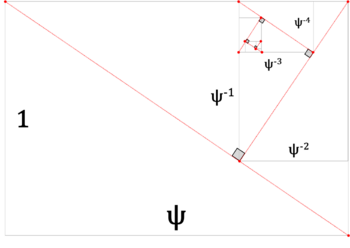Supergolden ratio
Template:Infobox non-integer number In mathematics, the supergolden ratio is a geometrical proportion close to 85/58. Its true value is the real solution of the equation x3 = x2 + 1.
The name supergolden ratio results from analogy with the golden ratio, the positive solution of the equation x2 = x + 1.

Definition
Two quantities a > b > 0 are in the supergolden ratio-squared if
- [math]\displaystyle{ \left( \frac{a+b}{a} \right)^{2} = \frac{a}{b} }[/math].
The ratio [math]\displaystyle{ \frac{a+b}{a} }[/math] is commonly denoted [math]\displaystyle{ \psi. }[/math]
Based on this definition, one has
- [math]\displaystyle{ \begin{align} 1&=\left( \frac{a+b}{a} \right)^{2} \frac{b}{a}\\ &=\left( \frac{a+b}{a} \right)^{2} \left( \frac{a+b}{a} - 1 \right)\\ &\implies \psi^{2} \left( \psi - 1 \right) = 1 \end{align} }[/math]
It follows that the supergolden ratio is found as the unique real solution of the cubic equation [math]\displaystyle{ \psi^{3} - \psi^{2} - 1 = 0. }[/math] The decimal expansion of the root begins as [math]\displaystyle{ 1.465\,571\,231\,876\,768... }[/math] (sequence A092526 in the OEIS).
The minimal polynomial for the reciprocal root is the depressed cubic [math]\displaystyle{ x^{3} +x -1 }[/math],[2] thus the simplest solution with Cardano's formula,
- [math]\displaystyle{ w_{1,2} = \left( 1 \pm \frac{1}{3} \sqrt{ \frac{31}{3}} \right) /2 }[/math]
- [math]\displaystyle{ 1 /\psi =\sqrt[3]{w_1} +\sqrt[3]{w_2} }[/math]
or, using the hyperbolic sine,
- [math]\displaystyle{ 1 /\psi =\frac{2}{ \sqrt{3}} \sinh \left( \frac{1}{3} \operatorname{arsinh} \left( \frac{3 \sqrt{3}}{2} \right) \right). }[/math]
[math]\displaystyle{ 1 /\psi }[/math] is the superstable fixed point of the iteration [math]\displaystyle{ x \gets (2x^{3}+1) /(3x^{2}+1) }[/math].
The iteration [math]\displaystyle{ x \gets \sqrt[3]{1 +x^{2}} }[/math] results in the continued radical
- [math]\displaystyle{ \psi =\sqrt[3]{1 +\sqrt[3/2]{1 +\sqrt[3/2]{1 +\cdots}}} }[/math] [3]
Dividing the defining trinomial [math]\displaystyle{ x^{3} -x^{2} -1 }[/math] by [math]\displaystyle{ x -\psi }[/math] one obtains [math]\displaystyle{ x^{2} +x /\psi^{2} +1 /\psi }[/math], and the conjugate elements of [math]\displaystyle{ \psi }[/math] are
- [math]\displaystyle{ x_{1,2} = \left( -1 \pm i \sqrt{4 \psi^2 + 3} \right) /2 \psi^{2} }[/math]
Properties
Many properties of [math]\displaystyle{ \psi }[/math] are related to golden ratio [math]\displaystyle{ \varphi }[/math]. For example, the supergolden ratio can be expressed in terms of itself as the infinite geometric series [4]
- [math]\displaystyle{ \psi^{3} = \sum_{n=0}^{\infty} \psi^{-n} }[/math],
in comparison to the golden ratio identity
- [math]\displaystyle{ \varphi^{2} = \sum_{n=0}^{\infty} \varphi^{-n} }[/math].
Additionally, [math]\displaystyle{ 1 +\varphi^{-1} +\varphi^{-2} =2 }[/math], while [math]\displaystyle{ \sum_{n=0}^{7} \psi^{-n} = 3. }[/math]
For all powers [math]\displaystyle{ \psi^{n} =\psi^{n-1} +\psi^{n-3} =\psi^{n-2} +\psi^{n-3} +\psi^{n-4} =\psi^{n-2} +2\psi^{n-4} +\psi^{n-6}. }[/math]
Continued fraction pattern of a few low powers
- [math]\displaystyle{ \psi^{-1} = [0;1,2,6,1,3,5,4,22,...] \approx 0.6823 }[/math] (13/19)
- [math]\displaystyle{ \ \psi^{0} = [1] }[/math]
- [math]\displaystyle{ \ \psi^{1} = [1;2,6,1,3,5,4,22,1,...] \approx 1.4656 }[/math] (22/15)
- [math]\displaystyle{ \ \psi^{2} = [2;6,1,3,5,4,22,1,1,...] \approx 2.1479 }[/math] (15/7)
- [math]\displaystyle{ \ \psi^{3} = [3;6,1,3,5,4,22,1,1,...] \approx 3.1479 }[/math] (22/7)
- [math]\displaystyle{ \ \psi^{4} = [4;1,1,1,1,2,2,1,2,2,...] \approx 4.6135 }[/math] (60/13)
- [math]\displaystyle{ \ \psi^{5} = [6;1,3,5,4,22,1,1,4,...] \approx 6.7614 }[/math] (115/17)
Notably, the continued fraction of [math]\displaystyle{ \psi^{2} }[/math] begins as permutation of the first six natural numbers; the next term is equal to their sum + 1.
The supergolden ratio is the fourth smallest Pisot number.[5] Because the absolute value [math]\displaystyle{ 1 /\sqrt{\psi} }[/math] of the algebraic conjugates is smaller than 1, powers of [math]\displaystyle{ \psi }[/math] generate almost integers. For example: [math]\displaystyle{ \psi^{11} = 67.000222765... \approx 67 + 1/4489 }[/math]. After eleven rotation steps the phases of the inward spiraling conjugate pair – initially close to [math]\displaystyle{ \pm 13 \pi/22 }[/math] – nearly align with the imaginary axis.
The minimal polynomial of the supergolden ratio [math]\displaystyle{ m(x) = x^{3}-x^{2}-1 }[/math] has discriminant [math]\displaystyle{ \Delta=-31 }[/math]. The Hilbert class field of imaginary quadratic field [math]\displaystyle{ K = \mathbb{Q}( \sqrt{\Delta}) }[/math] can be formed by adjoining [math]\displaystyle{ \psi }[/math]. With argument [math]\displaystyle{ \tau=(1 +\sqrt{\Delta})/2\, }[/math] a generator for the ring of integers of [math]\displaystyle{ K }[/math], one has the special value of Dedekind eta quotient
- [math]\displaystyle{ \psi = \frac{ e^{\pi i/24}\,\eta(\tau)}{ \sqrt{2}\,\eta(2\tau)} }[/math].
Expressed in terms of the Weber-Ramanujan class invariant Gn
- [math]\displaystyle{ \psi = \frac{ \mathfrak{f} ( \sqrt{ \Delta} )}{ \sqrt{2} } = \frac{ G_{31} }{ \sqrt[4]{2} } }[/math].[6]
Properties of the related Klein j-invariant [math]\displaystyle{ j(\tau) }[/math] result in near identity [math]\displaystyle{ e^{\pi \sqrt{- \Delta}} \approx \left( \sqrt{2}\,\psi \right)^{24} - 24 }[/math]. The difference is < 1/143092.
The elliptic integral singular value[7] [math]\displaystyle{ k_{r} =\lambda^{*}(r) }[/math] for [math]\displaystyle{ r=31 }[/math] has closed form expression
- [math]\displaystyle{ \lambda^{*}(31) =\sin ( \arcsin \left( ( \sqrt[4]{2}\,\psi)^{-12} \right) /2) }[/math]
(which is less than 1/10 the eccentricity of the orbit of Venus).
Narayana sequence
Narayana's cows is a recurrence sequence originating from a problem proposed by the 14th century Indian mathematician Narayana Pandita.[8] He asked for the number of cows and calves in a herd after 20 years, beginning with one cow in the first year, where each cow gives birth to one calf each year from the age of three onwards.
The Narayana sequence has a close connection to the Fibonacci and Padovan sequences and plays an important role in data coding, cryptography and combinatorics. The number of compositions of n into parts 1 and 3 is counted by the nth Narayana number.
The Narayana sequence is defined by the third-order recurrence relation
- [math]\displaystyle{ N_{n} =N_{n-1} +N_{n-3} }[/math] for n > 2,
with initial values
- [math]\displaystyle{ N_{0} =N_{1} =N_{2} =1 }[/math].
The first few terms are 1, 1, 1, 2, 3, 4, 6, 9, 13, 19, 28, 41, 60, 88,... (sequence A000930 in the OEIS). The limit ratio between consecutive terms is the supergolden ratio.
The first 11 indices n for which [math]\displaystyle{ N_{n} }[/math] is prime are n = 3, 4, 8, 9, 11, 16, 21, 25, 81, 6241, 25747 (sequence A170954 in the OEIS). The last number has 4274 decimal digits.
The sequence can be extended to negative indices using
- [math]\displaystyle{ N_{n} =N_{n+3} -N_{n+2} }[/math].
The generating function of the Narayana sequence is given by
- [math]\displaystyle{ \frac{1}{1 - x - x^{3}} = \sum_{n=0}^{\infty} N_{n}x^{n} }[/math] for [math]\displaystyle{ x \lt 1 /\psi }[/math]
The Narayana numbers are related to sums of binomial coefficients by
- [math]\displaystyle{ N_{n} = \sum_{k=0}^{\lfloor n / 3 \rfloor}{n-2k \choose k} }[/math].
The characteristic equation of the recurrence is [math]\displaystyle{ x^{3}-x^{2}-1=0 }[/math]. If the three solutions are real root [math]\displaystyle{ \alpha }[/math] and conjugate pair [math]\displaystyle{ \beta }[/math] and [math]\displaystyle{ \gamma }[/math], the Narayana numbers can be computed with the Binet formula [9]
- [math]\displaystyle{ N_{n-2} =a \alpha^{n} +b \beta^{n} +c \gamma^{n} }[/math], with real [math]\displaystyle{ a }[/math] and conjugates [math]\displaystyle{ b }[/math] and [math]\displaystyle{ c }[/math] the roots of [math]\displaystyle{ 31x^{3} +x -1 = 0 }[/math].
Since [math]\displaystyle{ \left\vert b \beta^{n} +c \gamma^{n} \right\vert \lt 1 /\sqrt{ \alpha^{n}} }[/math] and [math]\displaystyle{ \alpha = \psi }[/math], the number [math]\displaystyle{ N_{n} }[/math] is the nearest integer to [math]\displaystyle{ a\,\psi^{n+2} }[/math], with n ≥ 0 and [math]\displaystyle{ a =\psi /( \psi^{2} +3) = }[/math] 0.2846930799753185027474714...
Coefficients [math]\displaystyle{ a =b =c =1 }[/math] result in the Binet formula for the related sequence [math]\displaystyle{ A_{n} =N_{n} +2N_{n-3} }[/math].
The first few terms are 3, 1, 1, 4, 5, 6, 10, 15, 21, 31, 46, 67, 98, 144,... (sequence A001609 in the OEIS).
This anonymous sequence has the Fermat property: if p is prime, [math]\displaystyle{ A_{p} \equiv A_{1} \bmod p }[/math]. The converse does not hold, but the small number of odd pseudoprimes [math]\displaystyle{ \,n \mid (A_{n} -1) }[/math] makes the sequence special.[10] The 8 odd composite numbers below 108 to pass the test are n = 1155, 552599, 2722611, 4822081, 10479787, 10620331, 16910355, 66342673.
The Narayana numbers are obtained as integral powers n > 3 of a matrix with real eigenvalue [math]\displaystyle{ \psi }[/math] [8]
- [math]\displaystyle{ Q = \begin{pmatrix} 1 & 0 & 1 \\ 1 & 0 & 0 \\ 0 & 1 & 0 \end{pmatrix} , }[/math]
- [math]\displaystyle{ Q^{n} = \begin{pmatrix} N_{n} & N_{n-2} & N_{n-1} \\ N_{n-1} & N_{n-3} & N_{n-2} \\ N_{n-2} & N_{n-4} & N_{n-3} \end{pmatrix} }[/math]
The trace of [math]\displaystyle{ Q^{n} }[/math] gives the above [math]\displaystyle{ A_{n} }[/math].
Supergolden rectangle
A supergolden rectangle is a rectangle whose side lengths are in a [math]\displaystyle{ \psi:1 }[/math] ratio. Compared to the golden rectangle, containing linear ratios [math]\displaystyle{ \varphi^{2}:\varphi:1 }[/math], the supergolden rectangle has one more degree of self-similarity.
Given a rectangle of height 1, length [math]\displaystyle{ \psi }[/math] and diagonal length [math]\displaystyle{ \sqrt{\psi^{3}} }[/math] (according to [math]\displaystyle{ 1+\psi^{2}=\psi^{3} }[/math]). On the left-hand side, cut off a square of side length 1 and mark the intersection with the falling diagonal. The remaining rectangle now has aspect ratio [math]\displaystyle{ \psi^{2}:1 }[/math] (according to [math]\displaystyle{ \psi-1=\psi^{-2} }[/math]). Divide the original rectangle into four parts by a second, horizontal cut passing through the intersection point.
Numbering counter-clockwise starting from the upper right, the resulting first, second and fourth parts are all supergolden rectangles; while the third has aspect ratio [math]\displaystyle{ \psi^{3}:1 }[/math]. The original rectangle and successively the second, first and fourth parts have diagonal lengths in the ratios [math]\displaystyle{ \psi^{3}:\psi^{2}:\psi:1 }[/math] or, equivalently, areas [math]\displaystyle{ \psi^{6}:\psi^{4}:\psi^{2}:1 }[/math]. The areas of the diagonally opposite first and third parts are equal.[11][4]
In the first part supergolden rectangle perpendicular to the original one, the process can be repeated at a scale of [math]\displaystyle{ 1:\psi^{2} }[/math].
See also
- Solutions of equations similar to [math]\displaystyle{ x^{3}=x^{2}+1 }[/math]:
- Golden ratio – the only positive solution of the equation [math]\displaystyle{ x^{2}=x+1 }[/math]
- Plastic ratio – the only real solution of the equation [math]\displaystyle{ x^{3}=x+1 }[/math]
References
- ↑ Sloane, N. J. A., ed. "Sequence A092526". OEIS Foundation. https://oeis.org/A092526.
- ↑ (sequence A263719 in the OEIS)
- ↑ m/n√x = xn/m
- ↑ 4.0 4.1 Koshy, Thomas (2017) (in en). Fibonacci and Lucas Numbers with Applications (2 ed.). John Wiley & Sons. doi:10.1002/9781118033067.
- ↑ (sequence A092526 in the OEIS)
- ↑ Ramanujan G-function (in German)
- ↑ Weisstein, Eric W.. "Elliptic integral singular value". http://mathworld.wolfram.com/EllipticIntegralSingularValue.html.
- ↑ 8.0 8.1 (sequence A000930 in the OEIS)
- ↑ Lin, Xin (2021). "On the Recurrence Properties of Narayana's Cows Sequence" (in en). Symmetry 13 (149). doi:10.3390/sym13010149.
- ↑ Studied together with the Perrin sequence in: Adams, William; Shanks, Daniel (1982). "Strong Primality Tests that are Not Sufficient". Math. Comp. (AMS) 39 (159): 255–300. doi:10.2307/2007637.
- ↑ Crilly, Tony (1994). "A Supergolden Rectangle" (in en). The Mathematical Gazette 78 (483): 320–325. doi:10.2307/3620208.
 |





